Apr 15, 2020
The best and worst infielders in Blue Jays history
This list is evidence that impact and longevity together are hard to come by in the post-1990 landscape of professional sports, Scott Mitchell writes in the fifth of his nine-part series that looks at the best and worst in the franchise’s history.
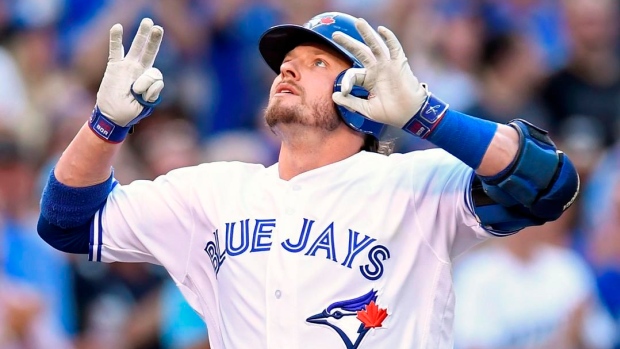
No matter the sport or the position, when debating the greats, it usually comes down to one conversation.
Longevity versus impact.
How you weigh those factors will be unique to the individual ranking them, and the reasoning will vary from player to player and resume to resume.
This list is evidence that impact and longevity together are hard to come by in the post-1990 landscape of professional sports, one that involves things like free agency, service time, arbitration, salary caps, luxury taxes, and players generally being viewed first and foremost as assets.
The inevitable strain that puts on player/front office relationships and the millions of dollars at stake usually leads to a divorce, whether it’s a trade or free agency.
Calling it rare for a player to spend his entire career with one team would be an understatement. It almost never happens and it’s a complete outlier when it does.
When it comes to the best infielders in Toronto Blue Jays franchise history, there are many strong cases relying on impact and, when it comes to Tony Fernandez and Carlos Delgado, an important mixture of both longevity and impactful numbers.
On the flip side, while most of the worst infielders in franchise history were one-and-done types, the numbers surprisingly reveal a longtime Blue Jay with some accolades to his name wasn’t exactly helping his young franchise’s case in the early 1980s, so longevity isn’t everything.
After looking at the best outfielders to ever do it last week, here are the best and worse infielders in Jays’ history.
The Best and Worst of the Blue Jays on TSN.ca:
Mon, April 6 – The five best and worst signings
Wed, April 8 – The five best and worst outfielders
Fri, April 10 – The five best and worst games
Mon, April 13 – The five best and worst trades
Wed, April 15 – The five best and worst infielders
Fri, April 17 – The five best and worst seasons
Mon, April 20 – The five best and worst draft picks
Wed, April 22 – The five best and worst pitchers
Fri, April 24 – The five best and worst moments
Best Infielders
5. (Tie) Fred McGriff (1986-90)/John Olerud (1989-96)
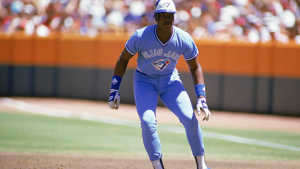 Including another guy you’ll read about on this list, there’s a rich history of first base production over the years in Toronto and it all started with the Crime Dog in the mid 1980s.
Including another guy you’ll read about on this list, there’s a rich history of first base production over the years in Toronto and it all started with the Crime Dog in the mid 1980s.
Stolen in a trade with the New York Yankees in 1982, Fred McGriff only played five seasons in a Jays uniform, but that half decade was a productive one, with the Tampa, Fla., native’s .919 OPS and .530 slugging percentage in 578 games both still sitting third in franchise history.
To put McGriff’s brief greatness in perspective, he produced 19.7 fWAR in just 2,322 trips to the plate, while Vernon Wells needed 5,963 plate appearances to accumulate 24.8 fWAR.
Once McGriff was dealt to San Diego in a swap for the ages, John Olerud took over the position and didn’t even need to play a game in the minors after being selected in the third round of the 1989 draft.
As amazing as that is, Olerud was able to hold his own early in his career, too, showing an ability to control the strike zone and get on base enough to offset middling power.
In 1993, Olerud put everything together and spent a memorable summer flirting with the .400 mark, ultimately finishing with a .363/.473/.579 slash line and a huge 8.1 fWAR as the most productive player on a squad littered with productive hitters.
While much of his prime came after he was traded away to the New York Mets, Olerud’s .293 batting average with the Jays is sixth all-time, while his .395 on-base percentage is the best in club history.
Both of these guys were quiet stars, but stars nonetheless.
4. Josh Donaldson (2015-18)
As mentioned, the main debate you can have when it comes to these lists is how you weigh longevity, tenure and consistency versus massive impact.
Donaldson was an impact choice here, spending only four seasons in a Jays uniform, and really it was only three because he was M.I.A. with a calf injury for most of 2018 until he was unceremoniously traded away at the waiver deadline.
I’ve talked about signature moments being part of this equation for me, and Donaldson’s 2015 American League MVP is exactly that.
Donaldson brought another element of swagger to a lineup that already had Edwin Encarnacion and Jose Bautista, helping the Jays back to the postseason for the first time in 22 years.
Totalling 8.7 fWAR and a .297/.371/.568 slash line in his first season in Toronto, Donaldson put together another huge year in 2016, before calf injuries and contract issues combined to sour the end of his tenure as a Blue Jay.
But still, Donaldson’s overall 22.2 fWAR is fourth among infielders in club history, despite playing only 462 games for the franchise, by far the fewest on this list.
It ended too quickly but Donaldson’s greatness and impact can’t be ignored.
3. Carlos Delgado (1993-04)
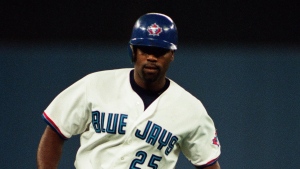 From a player whose Blue Jays resume was built on immediate impact and trips to the postseason in Donaldson, to Delgado, a man who unfortunately had to suffer through a down period following the World Series years.
From a player whose Blue Jays resume was built on immediate impact and trips to the postseason in Donaldson, to Delgado, a man who unfortunately had to suffer through a down period following the World Series years.
It took Delgado some time to get going — he was up and down between Toronto and Triple-A Syracuse in 1994 and ’95 — but once the big lefty found his stride he was one of the most consistent power threats in baseball.
Delgado hit 30 home runs in a season for the first time in 1996, kickstarting a run of 10 straight campaigns with 30 or more bombs, and three of those years he hit 40-plus.
Playing in an era of massive offensive numbers, Delgado’s career year came in 2000 when he slashed .344/.470/.664 with 41 homers and 137 RBI, walking more than he struck out.
After winning 90-plus games from 1991-93, the Jays never won more than 88 games in any of Delgado’s nine full seasons with the club.
Individually, however, Delgado’s name is everywhere in the Jays’ record books. He’s first in club history in OPS (.949), slugging (.556), plate appearances (6,018), runs scored (889), total bases (2,786), doubles (343), RBI (1,058), extra-base hits (690), intentional walks (128), as well as getting plunked (122).
Delgado’s 34.7 fWAR sits third in franchise history among position, just back of Jose Bautista club-leading 36.1 mark.
2. Tony Fernandez (1983-90, 1993, 1998-99, 2001)
It started to become a realization for me around the time of his unfortunate death due to complications from kidney disease in February that Fernandez wasn’t getting his due as one of the best players in club history.
Or maybe that’s just me.
Because of the fact much of his value was derived from defence and contact skills, Fernandez quietly went about his business for 17 major league seasons, including four separate stints in Toronto.
The ones that mattered were the first two.
Coming up in 1983 as a wiry shortstop with a smooth but unusual throwing motion, Fernandez quickly established himself as one of the best defensive shortstops in the game and a player who could annually threaten the .300 mark at the plate.
Sure, he didn’t hit with much power — Fernandez hit a career high 11 homers in a season twice, which is probably 20 if the ball was juiced up like it is today — but his .297 career batting average in a Jays uniform sits fifth on the all-time list, and it led to 1,583 hits, first in club history.
Fernandez also punched 1,160 singles in his Jays career, 223 more than any other Blue Jay, and his 72 triples are also first.
While playing a franchise-leading 1,450 games helped, Fernandez’s 35.1 fWAR sits second in team history for position players.
Traded away in the 1990 blockbuster, it was fitting that the long-time Blue Jay was able to return in ’93 to win a ring.
R.I.P, Mr. Fernandez.
1. Roberto Alomar (1991-95)
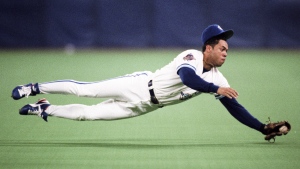 The first player in franchise history to go into Cooperstown with a Blue Jays plaque in 2011, Alomar, like a couple of names on this list, wasn’t around long enough, but the prime years he gave Toronto in ’92 and ’93 were everything.
The first player in franchise history to go into Cooperstown with a Blue Jays plaque in 2011, Alomar, like a couple of names on this list, wasn’t around long enough, but the prime years he gave Toronto in ’92 and ’93 were everything.
From signature moments like his ALCS home run in Oakland in ’92 to his flashy glove and 206 stolen bases, which puts him second in club history, Alomar was a catalyst and a star for the two best ballclubs this franchise has ever seen.
Alomar could do it all.
He got on base, played Gold Glove defence 10 times in his career, and when you needed a big hit, Alomar was there to provide it.
Three years in a row, from ’91 to ’93, he finished exactly sixth in AL MVP voting, and Alomar’s .307 batting average is second in club history to Paul Molitor’s .315 mark.
Totalling 63.6 fWAR over the course of his 17 seasons, 20.4 of that came in Toronto, leaving him 12th in club history across just 703 games.
Once you get past the numbers and the rings, Alomar was captivating to Toronto fans because of the flair he played the game with, and there wasn’t a single kid growing up in the 1990s who didn’t try to emulate Alomar’s style and grace at second base on the sandlot.
He may have played more games elsewhere, but Alomar’s hall-of-fame career was made as a Blue Jay.
Worst Infielders
5. Jarrod Saltalamacchia (2017)
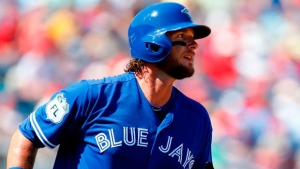 Coming off the playoff runs of 2015 and 2016, things soured quickly for the Jays as placeholder after placeholder was put into place as the front office waited for the minor-league system to start spitting out talent that mattered.
Coming off the playoff runs of 2015 and 2016, things soured quickly for the Jays as placeholder after placeholder was put into place as the front office waited for the minor-league system to start spitting out talent that mattered.
For his career, Jarrod Saltalamacchia wasn’t a bad player, but with his career fading he showed up in Toronto to start the season as Russell Martin’s backup and proceeded to get just one hit and strike out 16 times in 25 at-bats.
Where I’m from, a 61.5 per cent K-rate and a .040 batting average are … not good. The Jays quickly realized the mistake in April and cut bait.
4. Alfredo Griffin (1979-84, 1992-93)
If you sort the FanGraphs historical WAR leaderboard for all the qualified hitters in Blue Jays history, there are only four negative WAR totals.
Ryan Goins’ -0.2 mark in 449 games.
J.P. Arencibia’s -0.3 mark in 380 games.
Kendrys Morales’ -0.4 mark in 280 games.
Then there’s Alfredo Griffin.
Calling the 1979 co-American League rookie of the year one of the worst infielders in club history seems odd, but a staggering -3.2 fWAR total over his eight years in Toronto is hard
to shake.
Offensively, Griffin was a black hole for much of his career, making up a little bit of it by toting around a capable shortstop mitt.
The only positive WAR season Griffin had with the Jays, in fact, was that 1979 campaign in which he hit .287 with 21 stolen bases for Roy Hartsfield’s club.
Amazingly, he made the 1984 All-Star Game despite finishing with a .241/.248/.298 slash line.
While it may not feel like Griffin was one of the worst ever, the numbers say he was.
The baseball world sure was a different place back then.
3. Joe Lawrence (2002)
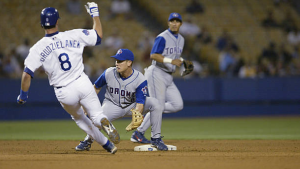 Joey Lawrence didn’t exactly Blossom — only a select few of you will get that terrible 1990s sitcom humour — in his lone season with the Jays, who drafted him 16th overall in 1996.
Joey Lawrence didn’t exactly Blossom — only a select few of you will get that terrible 1990s sitcom humour — in his lone season with the Jays, who drafted him 16th overall in 1996.
With the Jays on their way to another below .500 finish, they gave Lawrence some run at second base to see what he could do.
It did not go well.
Across 174 plate appearances, Lawrence slashed just .180/.262/.247, posting a 34 wRC+ and -0.9 fWAR.
He was out of baseball a year later.
2. Dave McKay (1977-79)
Once you drop the career plate appearance threshold to 500, McKay’s name pops up, as the Vancouver product really struggled in his three seasons in Toronto, resulting in -2.8 fWAR, which is second worst in club history between Griffin’s -3.2 and Danny Ainge (-2.2).
McKay batted just .223 with the Jays over 999 plate appearances, moving on to Oakland in 1980 with just a .566 OPS as a Blue Jay.
As you would expect with the names on this list, McKay’s career was pretty nondescript.
1. Carlos Garcia (1997)
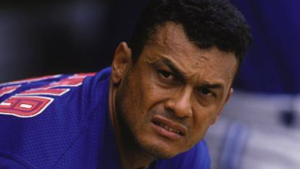 Front offices were getting smarter in 1997, but they were still far from analytical.
Front offices were getting smarter in 1997, but they were still far from analytical.
With that said, I still can’t figure out why anyone thought allowing Garcia to walk to the plate 381 times that year was a good idea.
Somehow, someway, in just 103 games, Garcia ran up a -2.2 fWAR total, doing far more harm than good when he was on the field.
The defence wasn’t good, the slash line of .220/.253/.309 was putrid, but GM Gord Ash kept him on the roster and manager Cito Gaston, who was fired with in the last week of the season, kept running Garcia out there.
It’s not shocking at all that the Jays finished in last place in the AL East that year.
An all-star with the Pittsburgh Pirates in 1994, Garcia only appeared in 25 major league games after his debacle with the Jays.


